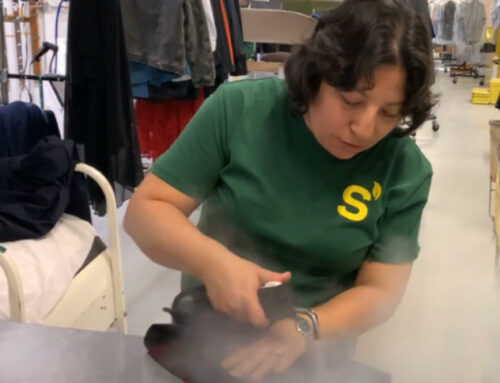By Susan Cook
A recent study has shed more light on the serious health risks associated with a common dry cleaning chemical called perchloroethylene (PERC). The study’s findings have raised concerns about the long-term effects of PERC exposure, particularly the link between PERC and Parkinson’s disease.
Over my 40 decades in the dry cleaning and laundry industry, I’ve worked in operations that used toxic cleaning solvents, and others that adopted non-toxic cleaning solutions. My experience has left me with a wealth of knowledge about various cleaning processes and their associated risks.
After reading this article, you’ll have a better understanding of the dangers of PERC and be better equipped to make informed decisions about your dry cleaning choices. Your health and safety are our priority, and I want to ensure you have the information you need to make the best clothing care decisions for yourself and your loved ones.
.png)
Understanding PERC: Its Uses and Prevalence
Before we dive into the health risks associated with PERC, it’s essential to understand what it is and why it’s used in the dry cleaning industry. PERC, or perchloroethylene, is a colorless, nonflammable liquid with an anesthetic-like odor. It has been widely used as a dry cleaning solvent since the 1930s due to its ability to dissolve grease, oil, and dirt from fabrics without shrinking them.
Despite the growing concerns about PERC’s potential health risks, it remains the most commonly used dry cleaning solvent in the United States, accounting for around 70% of all dry cleaning operations. In addition to dry cleaning, PERC is also used as a degreasing agent in various industries, including automotive and metalworking, and as a component in some adhesives, paint removers, and carpet cleaners.
The prevalence of PERC means that many people may be unknowingly exposed to it through their dry-cleaned garments, household products, and even their drinking water. In fact, it’s been reported that PERC is the most common organic contaminant found in groundwater, detected in up to 30% of drinking water supplies in the United States. This widespread exposure to PERC is precisely why understanding its potential health risks is so crucial.
.png)
The Dangers of PERC Exposure: From the Workplace to Your Home
The new study demonstrates a connection between PERC and Parkinson’s disease. The study looked at a cohort of human twins wherein one twin had been occupationally exposed to PERC and other chemicals believed to be linked to the development of Parkinson’s.
In this section, we’ll delve into the various ways PERC can pose risks to human health, both in occupational settings and through off-gassing in our homes.
Occupational Exposure:
Workers in dry cleaning facilities and other industries that use PERC are at a higher risk of exposure to the chemical. Long-term exposure to high levels of PERC can lead to serious health issues, including liver and kidney damage, respiratory problems, and neurological effects such as memory loss and impaired cognitive function. Additionally, PERC is considered a “likely human carcinogen” by the International Agency for Research on Cancer (IARC), meaning it may cause cancer in humans.

Off-gassing in Homes:
When you bring your drycleaned clothes home from a traditional PERC drycleaner, they may still contain residual amounts of PERC. As the chemical evaporates, it is released into the air, creating an invisible but potentially dangerous indoor air pollutant. Off-gassing is more likely to occur in poorly ventilated spaces and can be especially problematic when dry-cleaned garments are stored in small, enclosed areas like closets.
Health Risks Associated with PERC Off-Gassing:
Inhaling PERC vapors can lead to a range of health issues, including dizziness, headaches, respiratory irritation, and even damage to the nervous system. Long-term exposure to low levels of PERC, such as those found in off-gassing scenarios, has been linked to an increased risk of certain types of cancer, liver and kidney damage, and reproductive problems.
How to Reduce Your Exposure to PERC Off-Gassing:
If you must use a traditional PERC dry cleaner, you can minimize the risk of PERC off-gassing in your home by taking these precautions:
- Remove the plastic garment bags and air out your clothes outdoors or in a well-ventilated area with plenty of space between each item for 24 hours before bringing them into your home.
- Use extra precaution with thicker items like comforters, pillows, and heavy coats, as they require more time to completely off-gas PERC vapors.
- Use an air purifier with an activated carbon filter to help remove VOCs, including PERC, from your indoor air.
By taking these steps, you can significantly reduce your exposure to PERC off-gassing and protect the health of your family.
.png)
The Path Forward: Green Alternatives to PERC
As we’ve explored the hazards posed by PERC to both human health and the environment, it’s important to consider safer alternatives for the dry cleaning industry. By choosing environmentally friendly dry cleaning methods, you can protect yourself, your family, and the planet from the harmful effects of PERC. Here are some green alternatives to traditional dry cleaning that you should be aware of:
Wet Cleaning:
Wet cleaning is a water-based, non-toxic cleaning process that uses biodegradable detergents and specialized equipment to clean delicate fabrics without the shrinkage of traditional laundry methods. Wet Cleaning is gentle on clothing and is considered to be one of the most environmentally friendly alternatives to dry cleaning.
Liquid Carbon Dioxide (CO2) Cleaning:
Liquid CO2 cleaning utilizes pressurized carbon dioxide in combination with non-toxic cleaning agents to remove dirt and stains from garments. This method is energy-efficient and generates minimal waste, making it an eco-friendly choice for dry cleaning.
Silicone-Based Cleaning (GreenEarth):
GreenEarth cleaning uses a silicone-based solvent called siloxane (D5) to clean garments. Siloxane doesn’t pose the same health risks, and it breaks down into harmless compounds when released into the environment.
Hydrocarbon Cleaning:
Hydrocarbon cleaning uses petroleum-based solvents as an alternative to PERC. Although this method is less hazardous to human health than PERC, it is still not the most eco-friendly option due to the use of non-renewable resources and potential environmental pollution.
As a consumer, you can make a difference by choosing to patronize dry cleaners that use eco-friendly methods. By doing so, you’ll not only protect your health and the health of your family, but you’ll also contribute to a cleaner, greener future for our planet.
Charting the Course to Healthier Clothing Care Choices
When you found this article, you might have been concerned or even unaware of the potential risks linked to the widely used dry cleaning solvent, PERC.
In this article, you learned about the health hazards associated with PERC and how it can impact not only the environment but also your health and the health of your family. With this newfound knowledge about the dangers of PERC and its impact on both your health and the environment, you can now make informed and conscious decisions about your clothing care choices that align with your values and preferences.
If you have more questions or concerns about PERC and its effects on your health or the environment, don’t hesitate to reach out to us. We are committed to providing you with the most up-to-date information and helping you make the best choices for your clothing care needs. Together, we can work towards a healthier and more sustainable future in garment care. If you’re interested in learning more about other common chemicals used in the dry cleaning industry, be sure to check out this article on the topic in our Learning Center.





